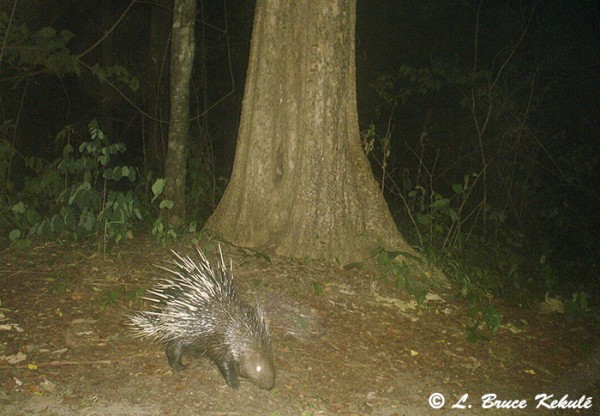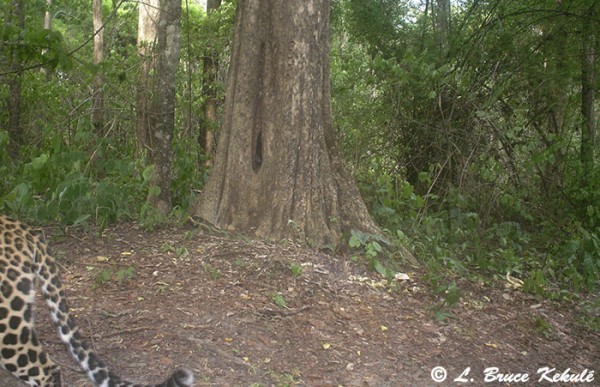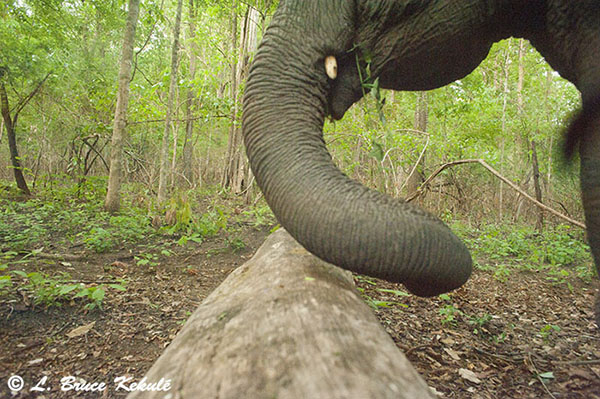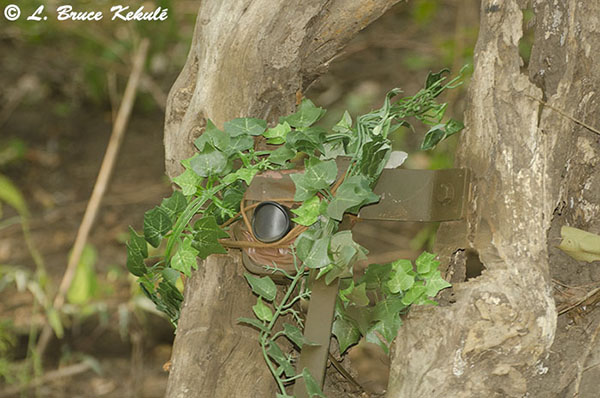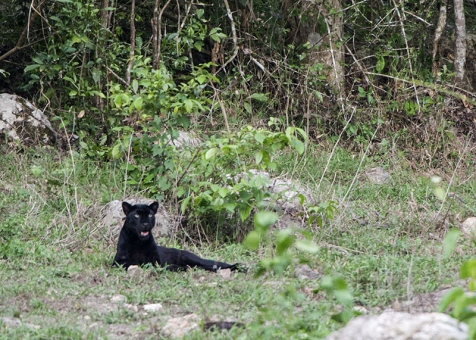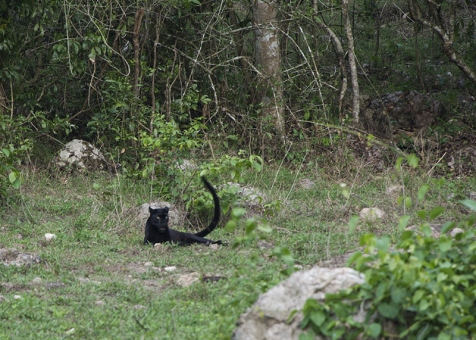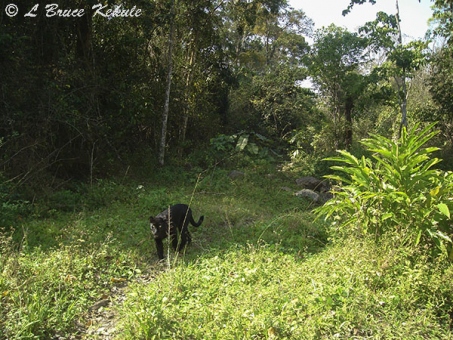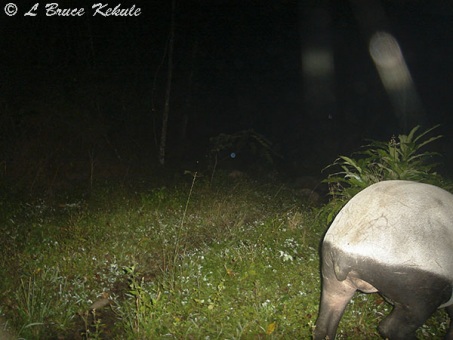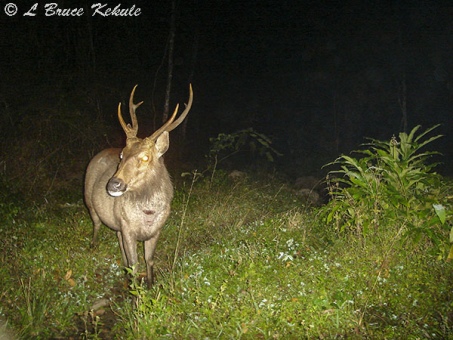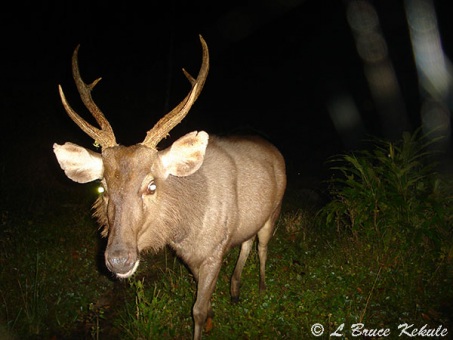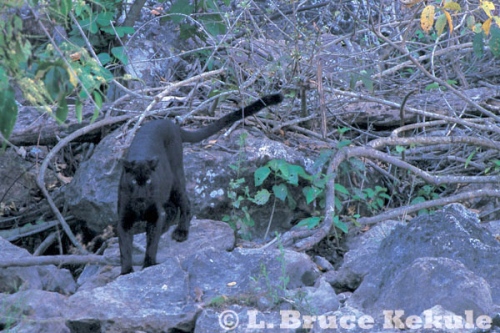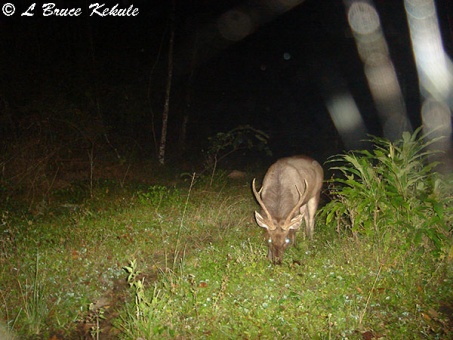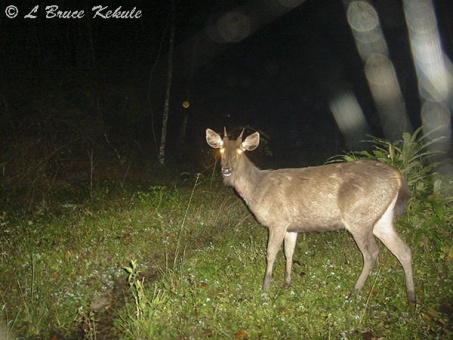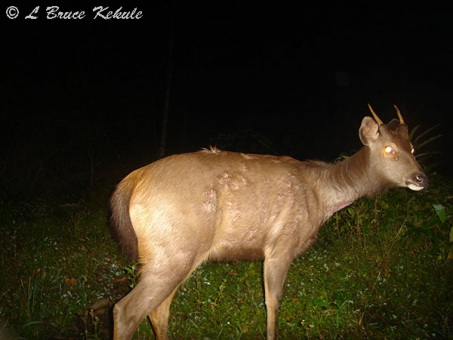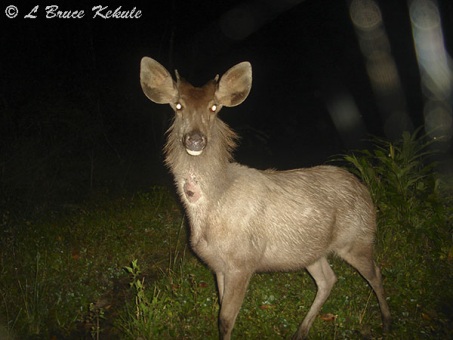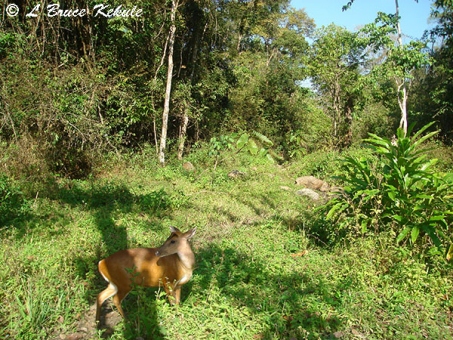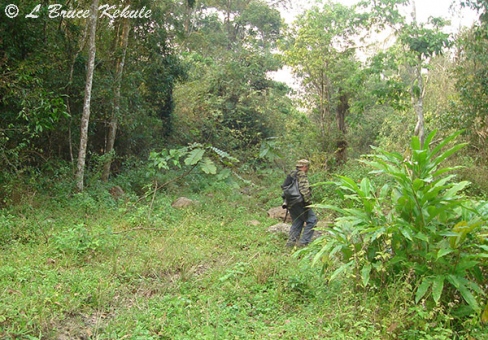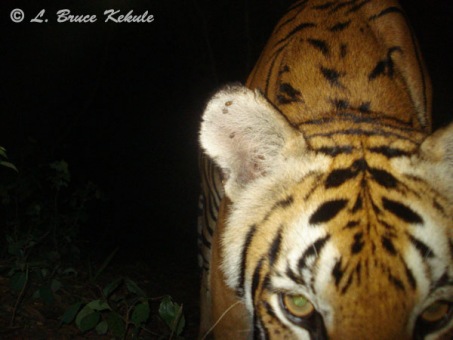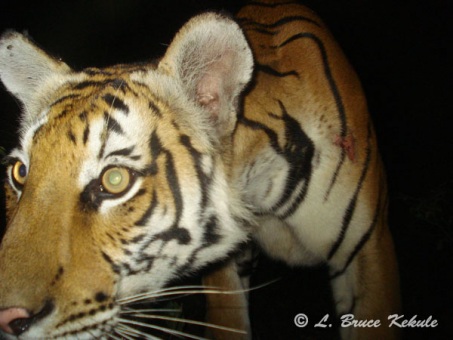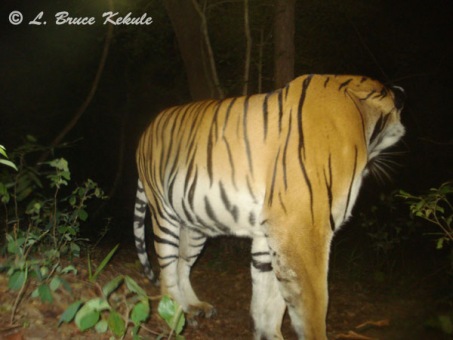Posts Tagged ‘asian leopard’
Sony P41 trail cam catches Asian wildlife
Leopard, bear, elephant and other rare creatures caught by a home brew ‘point and shoot’ camera trap
A black-phase leopard.
As I was in the forest checking my DSLRs last month, this little area where I park my truck looked like it might be promising and most likely used by some cryptic wildlife. I decided to setup my old Sony P41/BF board/Pelican 1040 with two ‘C’ cell externals (built for me by Dave, the old owner of BFOutdoors.com).
A yellow-phase male leopard.
An Asian black bear.
The cam is encased in an ‘elephant proof’ box attached to a tree and locked down with a Python cable. I’ve had this cam since 2008 and it’s still working very well. I usually carry a few of my old ‘point-n-shoots’ in the truck in case I need to survey a new trail or location like this.
A female muntjac (barking deer).
A green peafowl.
A couple weeks later, I was back and found a whole slew of animals had come by. A black leopard was the first through followed by a yellow-phase leopard, a muntjac (barking deer) and then a black bear. Other creatures that also came were green peafowl, elephant, large Indian civet, porcupine, several smaller civets and finally the tail end shot of a leopard again in daytime.
An Asian elephant – some strange flare.
Even though some of these photos are not the best, they are a good indication of what passes through. I previously got a tiger 50 meters from here. I have already decided to set-up a DSLR across from this tree and worked out where the flash and sensor positions would go…it looks very promising….I just gotta get back there…to be continued…!
A large Indian civet.
An Asian porcupine.
The tail-end of a leopard.
Look what I missed…!
Last month, an elephant destroyed one of my slave flashes on the D700 causing a shut down of the system due to a short in the flash cable. I left the cam for awhile longer with only two slaves but nothing crossed over the ‘tiger log’. I then decided to bring the setup to Bangkok to repair the third flash. I left a Bushnell Trophy Cam in place to see what wildlife would come to the ‘tiger log’.
Well as luck will have it, an Asian black bear (Ursus thibetanus) came up to the log but did not cross. Some thirty minutes later, a yellow phase leopard (Panthera pardus) jumped up on the log and posed. The next day, a tiger (Panthera tigris) passed by very quickly proving once again that this location continues to produce images of Thailand’s top predators on a regular basis.
My D700 is now back on the log and was working well when I left it two days ago. It is hoped that the ‘big cats’ will continue to cross over the log and trip the sensor…
Nikon D700 catches a male leopard on one paw…!
A big cat crossing the ‘tiger log’
Male leopard shot #1.
Male leopard on one paw….shot #2.
Male elephant – the flash destroyer.
Elephant back for more.
Banteng bull.
Evert year, forest fires occur in Thailand’s ‘Western Forest Complex’ during the dry season usually started by the human population living around the protected areas. Occasionally, lightning ignites fires but this natural phenomena, is less frequent. Stray cigarette butts also account for many fires. For the most part, local poachers start them to allow long distance spotlighting during the night. With the brush gone, they are able to see the reflection in the eyes distinctly (usually deer) with their headlamps.
Occasionally these fires are fierce and any camera trap left in the forest during this time will likely be destroyed. I always move my cams to evergreen forests from about February through to April that normally do not have fire, and this year was no different. But as soon as the first monsoon rains come in mid-April, the forest is safe once again for camera trapping.
With the first good rains through, I decided to setup my Nikon D700 back on the log. This time the cam is using a hardwired SSII sensor (Snapshotsniper.com) with a 10-meter cable setup in the tree stump apposite the cam. Also, a third flash was added and installed above the cam’s ‘elephant proof ‘ box. However, the ‘third flash’ is now history as a young tusker found it and turned it into rubble (below) but the cam, the sensor and two other flashes survived.
It was great to see this male leopard cross over the log. The first image is a good record shot but the second one is really something special catching this mature predator on one paw with the other three in mid-air. Also, the reproductive organ is sharp and just hanging there with its tail is balancing the big cat. He looks like he is winking at the cam. Once again, within two shots, the leopard turned his head to see what the flash was all about just like my tiger in late January 2014. The speed and reaction time of these felines is legendary and it doesn’t get any better…!
I also got the elephant that destroyed the third flash plus a banteng bull that stopped short but did not cross over. All in all, it was a great start to a new season at the ‘tiger log’. The full-frame D700 firing off a two-shot burst is in its element with a 28mm lens but now with only two flashes thanks to the forest giant. I have installed a 35mm lens this time to see what a tighter crop will do. Enjoy..!
Damaged SB-28 flash.
Nikon D700 setup on the log.
Hardwired external SSII (Snapshotsniper.com) sensor.
Hardwired Nikon SB-28 flash setup.
*****************************************
D700 settings: ƒ8 – 1/125 at ISO 400.
Edited in Adobe Camera Raw.
Leopard shot #1: full-frame.
Leopard shot #2: cropped.
Elephant and banteng bull: full-frame.
University of Tennessee Wildlife Presentation – November 11, 2013
This is ‘Part One’ titled ‘Chasing a Wild Dream – Predators’ of the presentation I did for the Biology Club at the University of Tennessee on Veteran’s Day, November 11, 2013. There is some old footage but some new including a black leopard in the early morning walking by my cam..one of my favorite videos…..enjoy..!
This is ‘Part Two’ titled ‘Chasing a Wild Dream – Herbivores’. Again, some old and some new….enjoy..!
A ‘Black Leopard’ again..!
An extraordinary sighting in Huai Kha Khaeng Wildlife Sanctuary
A black leopard resting at the hot spring.
Sometimes things happen in succession that boggles the mind. On May 6th I posted a tale about a ‘black leopard’ plus other Asian wild animals caught by my Sony S600 cam on a trail into a hot spring in Huai Kha Khaeng Wildlife Sanctuary, western Thailand where I’m currently running a camera trap program.
Entering the hot spring.
I also mentioned in the story that I photographed a ‘black leopard’ from a tree blind some 15 years ago just up the trail a bit. The ‘leopard spots’ image is one of my all-time favorite wildlife photographs ever. http://brucekekule.com/camera_trapping/a-black-leopard-passes-my-camera-trap/
Leaving the hot spring.
On May 7th, I was back at the hot springs to set camera traps, and to sit at the base of the old tree for some through-the-lens work. Who knows what might show-up.
I was with my friend Sarawut Sawkhamkhet, a Thai wildlife photographer. We arrived and set-up a temporary blind about 3pm. The weather was warm and balmy with nice clear-blue skies.
A full-frame shot.
At 5:45pm, the unthinkable happened! A ‘black leopard’ appeared out of the forest near the springs and walked over for a drink, and then disappeared for a short while. Then the magnificent creature came back and flopped down on all fours twitching its tail looking straight at us staying for about 10 minutes before going back in the forest where it had come from.
Kabook Kabieng hot springs deep in the interior.
I would venture to say, this is the same cat I camera trapped back in February and it could also be an offspring of my original leopard back in 1998. Who knows? I was elated to say the least.
To see and photograph a black leopard once again at this same location after all these years is something out of the extraordinary. When time permitted, I set one of my trusty Sony S600 cams at the hot spring and will go back in a couple of weeks to see what has visited the waterhole.
Then I intend to set a DSLR Nikon or Canon camera trap with several flashes for improved images. This place is truly worth the effort, time and difficulty to get here. I look forward to more incredible images from this wildlife haven.
A Black Leopard passes my camera trap
A series of images captured with a Sony S600 camera trap
A black leopard in mid-afternoon on a trail to a hotspring in Huai Kha Khaeng (cropped).
It is now late April in the forest of Huai Kha Khaeng Wildlife Sanctuary, my favorite-place in Thailand. The first rains have come and doused the dangerous forest fires that spread through the sanctuary during the dry hot season starting in March.
Full frame shot of the leopard.
As usual, I’m setting-up camera traps at various mineral deposits (natural seeps) around a ranger station deep in the interior accessible only by a dirt road. These waterholes are visited by all the large mammals including tiger and leopard, and provide excellent opportunities for some great animal shots.
An Asian tapir passes by.
As I was going through a few of my old camera traps changing out cards and batteries, I decided to have a quick look at a 2GB card that was in my Sony S600/SSI/1020, one of my first cams using a Pelican box.
A young ‘tusker’ on the trail showing off.
Imagine my surprise to see a shot of a ‘black leopard’ in mid-afternoon walking on the trail. Other denizens caught include elephant, tapir, sambar, wild pig and muntjac (barking deer) over a month period back in February to early March of this year. The cam recorded some 400 images mostly elephants and sambar. It truly was a bonus and I actually closed out the program with this cam.
Sambar stag on the trail.
I actually forgot to download the card and if I had formatted it, only a recovery program could have got them back as long as I had not filled the card with other images. Been there done that…!
Another sambar stag checking out my cam.
The black leopard brought back fond memories of this place more than 15 years ago. I was sitting in a tree blind up by the hot springs when a black leopard walked in about 4pm and posed for me at several places for over an hour.
My first black leopard in the late afternoon sun showing its spots.
The mature cat up at the hot springs.
My leopard posing on a fallen tree.
These were in the old days of slide film, and I did not know how good the shots were until the film was processed. Here are a few images from that lucky sequence many years ago.
The morel of this story: Make sure you double-check and download all your cards before formatting, or you may loose some valuable images like I almost did…!
Some other images from this set:
A very young elephant checking out the cam.
Looks like the bigger elephant lost part of its tail.
A youngish elephant on the trail.
Same elephant checking out the cam.
A sambar stag feeding on grass.
A mature sambar stag.
A young sambar stag.
Another spike stag with blotches.
And yet another spike stag.
A sambar doe.
Sambar doe close-up.
A wild pig in the late afternoon.
A muntjac (barking deer) early in the morning.
The ‘tiger hunter’ after setting the cam.
Leopards camera trapped on a kill in Huai Kha Khaeng Wildlife Sanctuary
Leopards at a sambar kill in Huai Kha Khaeng Wildlife Sanctuary, western Thailand. This rare camera trap photo was a complete surprise to see a yellow phase mother leopard and a young black cub. There are many black leopards in this protected area and it is a tribute to its status as a World Heritage Site.
Chasing a Wild Dream
A video about Thailand’s Amazing Wildlife in the Western Forest Complex. From wild elephants to green peafowl, this film shows the world the wildlife in the Kingdom’s protected areas, and the need to save this wonderful natural heritage for present and future generations to come.
In the heart of Southeast Asia, the Kingdom is blessed with some of the best and last remaining examples of Asian animals and ecosystems that harbor the tiger, leopard, elephant, gaur, banteng, wild water buffalo, tapir, sambar, muntjac, gibbon, green peafowl, hornbill, plus thousands of other amazing creatures and biospheres that have evolved over millions of years and show-case Mother Nature and her magnificent beauty…!
Huai Kha Khaeng: A birthday tiger and leopard
A new Sony W55 trail camera catches the big cats
On May 19th (my birthday) 2012, I decided to celebrate in the forest after returning to Thailand from a two-week photographic safari in Africa. It was once again a great trip to the Dark Continent and I managed to photograph the ‘Big Five’ (three times now) plus a multitude of other animals including some rare species like black-mane lion, black rhino, striped hyena, sable antelope and bush baby. I also got many other common animals like elephant, buffalo, giraffe, zebra, warthogs and antelopes. I also managed to catch Mount Kilimanjaro when the clouds lifted. Kenya is absolutely one of the greatest natural spectacles on the planet and I look forward to returning next year.
A male leopard caught by a Sony W55 homebrew trail camera trap
However, there are still a few wild places in Thailand that harbor many magnificent Asian creatures such as tiger, leopard, elephant, gaur, banteng plus many other mammals, birds, reptiles, insects and plant species. Huai Kha Khaeng is one of the top wildlife sanctuaries in Southeast Asia, and the world for that matter.
Leopard caught again checking out the camera
To get there, it takes about five hours by vehicle from Bangkok and is tucked away in the forested mountains of central-western Thailand in Uthai Thani province. I have written many stories about this place and its wildlife, and it never fails to live up to its status as a ‘World Heritage Site’ but this time it turned out even better than my wildest dreams.
A young female tiger caught by the Sony w55 trail cam
My birthday wish to catch a tiger and leopard up-close with one of my camera traps was granted by the ‘spirits of the forest’ and all the hard work building the cams, setting them up, waiting while they soaked and then the pain-staking collection was truly worthwhile.
My favorite shot of this young tiger
Arriving early in the morning, I got everything ready and went out to check the cams. One location has been extremely productive and had been very lucky catching tiger and leopard almost every time (three months in a row). When I went through the photos on my new Sony W55/SSII/1020/3 AA externals, I could not resist shouting out loud with one big hurrah. A leopard had stopped at the cam for a few shots and a night later, a tiger posed for a whole series of close-ups from the low-down set-up. I was speechless for a few seconds.
Check-out the ticks and markings on the right ear
Remember this tiger eye and ear
This game trail is situated deep in the protected area and many animals use it to get to a mineral lick and waterhole. The balance of nature is in full force here and ‘eat or be eaten’ carries on everyday. There is a fallen tree right across the trail about 500 meters from the dirt road some 15 kilometers in the sanctuary.
More ticks and note the wound on the left shoulder
Both of these big cats jump this log as they hunt for prey but usually a few days or two apart. The leopard is a very mature male but the tiger is a young female that seems to may have finally left her mother. I have a close-up shot of this same cat captured together in March and identified it as the same tiger two months ago by markings on the right ear. What a coincidence!
Stripe-pattern on right side used to identify this cat
All I can say is: this has been the best birthday in many moons and I know that my prayers are really answered from time to time. It is hoped this young tiger will continue to live out its life in safety and carry on its legacy as the world’s largest cat. Huai Kha Khaeng is truly a remarkable place and I have not even scratched the surface of this amazing wilderness!









